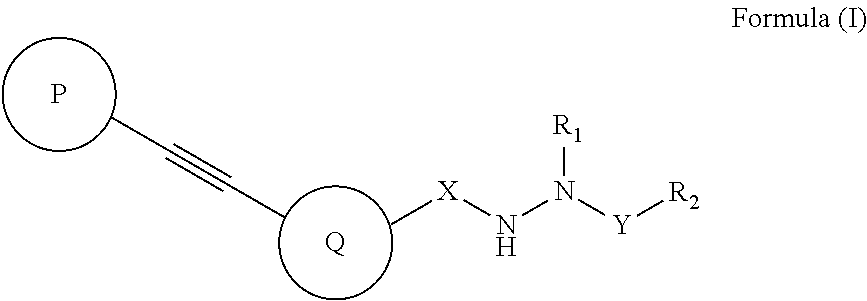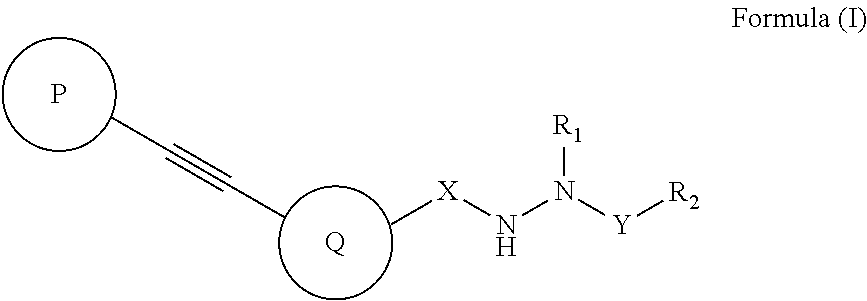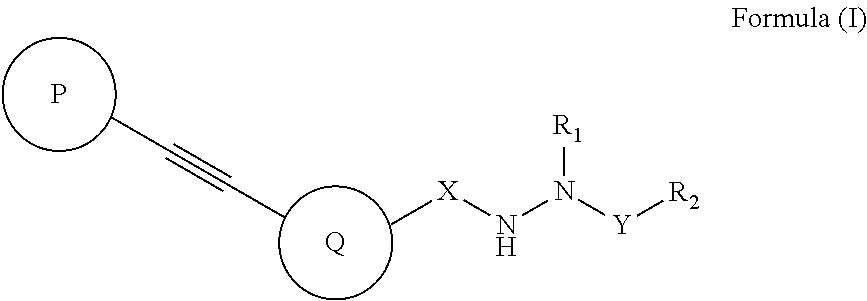Diarylacetylene hydrazide containing tyrosine kinase inhibitors
a technology of tyrosine kinase inhibitor and diarylacetylene hydrazide, which is applied in the preparation of hydrozide, organic chemistry, antineoplastic agents, etc., can solve the problems of reducing the factor that limits increasing the activity of tk, and much less effectiv
- Summary
- Abstract
- Description
- Claims
- Application Information
AI Technical Summary
Benefits of technology
Problems solved by technology
Method used
Image
Examples
reference example 1
Methyl 3-ethynyl-4-methylbenzoate
[0154]
[0155]A mixture of methyl 3-iodo-4-methylbenzoate (2.0 g, 7 mmol), trimethylsilylacetylene (1.2 ml, 8 mmol), Pd(PPh3)4 (0.42 g, 0.3 mmol), CuI (0.137 g, 0.7 mmol) and diisopropylethylamine (2.5 ml, 11.4 mmol) in THF (20 ml) was heated at 50° C. for 12 hrs under nitrogen atmosphere. The reaction mixture was cooled to ambient temperature and filtered through a Celite® bed. The clear filtrate was concentrated and the residue purified by flash chromatography on silica gel (elution with 2% ethyl acetate in n-hexane) to provide methyl 4-methyl-3-[(trimethylsilyl)ethynyl]benzoate.
[0156]To the solution of methyl 4-methyl-3-[(trimethylsilyl)ethynyl]benzoate (2.3 g) in THF (40 ml) was added tetrabutylammonium fluoride (1.0M in THF, 3.2 ml, 11 mmol) at ambient temperature and stirred for 15 minutes, concentrated and the residue purified by flash chromatography on silica gel (elution with 2% ethyl acetate in n-hexane) to provide methyl 3-ethynyl-4-methylbe...
reference example 2
4-Methyl-3-[(quinolin-3-yl)ethynyl]benzoic acid
[0161]
[0162]A mixture of methyl 3-ethynyl-4-methylbenzoate (0.341 g, 2 mmol), 3-iodoquinoline (0.5 g, 2 mmol), Pd(PPh3)4 (0.11 g, 0.01 mmol), CuI (0.179 g, 0.1 mmol) and diisopropylethylamine (0.5 ml, 3 mmol) in DMF (15 ml) was stirred at ambient temperature for 12 hrs under an atmosphere of nitrogen. The reaction mixture was concentrated and the crude product was purified by flash chromatography on silica gel (elution with 10% ethyl acetate in n-hexane) to provide methyl 4-methyl-3-[(quinolin-3-yl)ethynyl]benzoate.
[0163]Sodium hydroxide (0.15 g, 3.71 mmol) was added to a solution of the above methyl ester in methanol (20 ml) and water (3 ml) and stirred at 50° C. for 3 hrs and then concentrated in vacuo. Water (10 ml) was added to the residue, adjusted pH to 4.0-4.5 with citric acid. The solid obtained was filtered, washed successively with water and diethyl ether and dried at ambient temperature to obtain 4-methyl-3-[(quinolin-3-yl)et...
reference example 3
4-Methyl-3-[2-(3-quinolyl)ethynyl]benzohydrazide
[0178]
[0179]A mixture of 4-methyl-3-[(quinolin-3-yl)ethynyl]benzoic acid (0.15 g, 0.5 mmol), N-(3-dimethylaminopropyl)-N′-ethylcarbodiimide hydrochloride (0.15 g, 0.7 mmol) and 1-hydroxybenzotriazole (0.1 g, 0.7 mmol) in N,N-dimethylformamide (15 ml) was stirred at room temperature for 1 hr. Hydrazine hydrate (1.52 ml, 0.5 mmol) was then added and the mixture stirred for another 3 hrs. Concentration and trituration of the residue with water produced a solid which was filtered, washed successively with water and diethyl ether, and finally dried in vacuo to get the hydrazide as a pale yellow solid.
[0180]1H NMR (400 MHz in DMSO-d6), δ 2.63 (s, 3H), 4.79 (s, 2H), 7.51 (d, J=8.0 Hz, 1H), 7.75 (t, J1=14.7 Hz, J2=7.6 Hz, 1H), 7.85-7.96 (m, 2H), 8.09-8.13 (m, 3H), 8.73 (s, 1H), 9.09 (s, 1H), 9.91 (s, 1H).
[0181]Similarly were prepared the following acid hydrazide compounds from the corresponding acids:[0182]4-Methyl-3-[2-(3-pyridyl)ethynyl]benz...
PUM
 Login to View More
Login to View More Abstract
Description
Claims
Application Information
 Login to View More
Login to View More - R&D
- Intellectual Property
- Life Sciences
- Materials
- Tech Scout
- Unparalleled Data Quality
- Higher Quality Content
- 60% Fewer Hallucinations
Browse by: Latest US Patents, China's latest patents, Technical Efficacy Thesaurus, Application Domain, Technology Topic, Popular Technical Reports.
© 2025 PatSnap. All rights reserved.Legal|Privacy policy|Modern Slavery Act Transparency Statement|Sitemap|About US| Contact US: help@patsnap.com



